Table of Contents
ToggleIntroduction
As a versatile, high-level programming language, Python has become very popular across diverse domains. A wide spectrum of industries and functionalities use Python-based applications. As of 2024, Python is the third most used programming language used by developers worldwide. Moreover, the rapid adoption of Industry 4.0 technologies has been fueling the demand for Python in the end-use applications. In fact, the market size of Python is expected to reach USD 100.6 million by 2030. This makes it compelling to know more about Python and the trending applications developed using Python. Read on to know more.

Don't miss out on your chance to work with the best!
Apply for top job opportunities today!
Python: An Overview
Python is known for its simplicity, readability, and versatility. It is high-level, interpreted, dynamically typed, and a popular choice for beginners and experienced developers. Python was created by Guido van Rossum in the late 1980s and since then, has gained popularity due to its broad community support, ease of learning, and extensive standard library. Here are a few striking features of Python:
- Free and Open Source
- Easy to Code and Read
- Object-Oriented Language
- GUI Programming Support
- High-Level Language
- Large Community Support
- Easy to Debug
- Portable
- Interpreted and Integrated
- Large Standard Library
- Dynamically Typed Language
- Frontend and Backend Development
- Dynamic Memory Allocation
Why Is Python So Popular?
As a Python developer looking to thrive in 2024 and beyond, it is important to understand the ever-evolving tech landscape. For instance, what makes Python a preferred choice even after so many years? Let’s briefly look at the benefits of using Python.
Benefits of Using Python
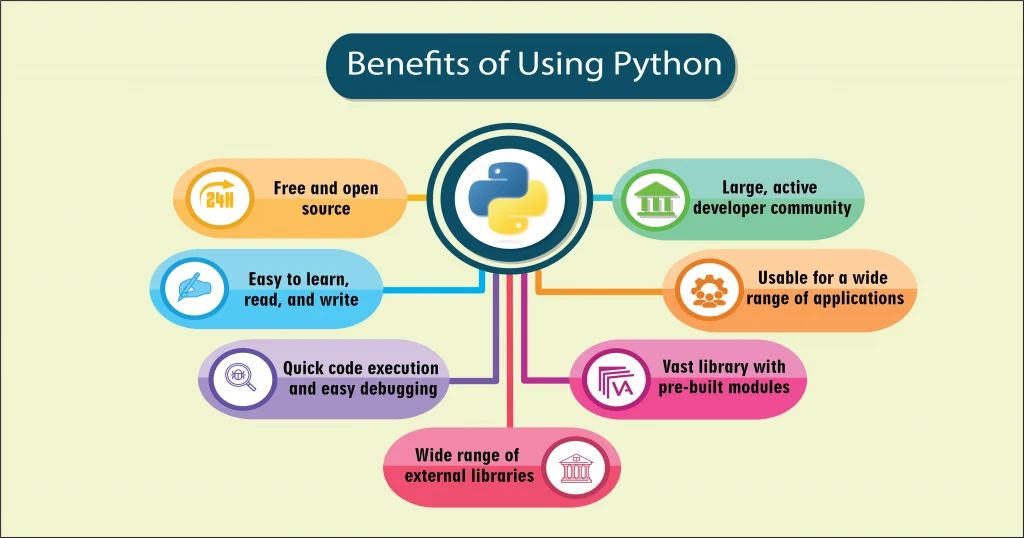
- Python can be used for a wide range of applications including web development, data science, machine learning, etc.
- Its simple syntax is easy to learn, read, and write.
- Python has a large, active developer community.
- It is open source and free for use and modification.
- Python offers quick code execution and easy debugging.
- It has a vast library with pre-built modules and functions.
- Python has a wide range of external libraries.
Top 14 Python Applications In 2024
Industry 4.0, or the Fourth Industrial Revolution is a topic of interest, especially from the point of view of digitization within the manufacturing industry. As a dynamic programming language, Python is being widely used across domains, including the manufacturing industry. The rapid adoption of Industry 4.0 technologies has led to a growing dependency on Python over other programming languages. For instance, there has been an increase in the demand of Python for real-time Internet of Things (IoT).
Here are the top 14 Python applications trending in 2024.
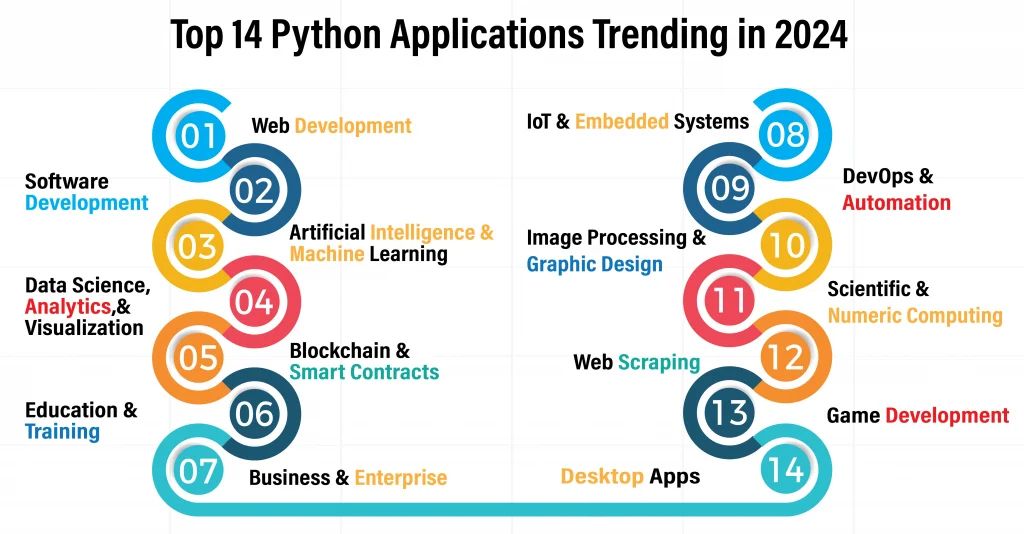
1. Web Development
Your Python skills can be used to work on a range of web development projects. Like JavaScript, Python also has an impressive range of web application frameworks, modules, and libraries that can help developers build content web applications, management systems, real-time apps, APIs, data dashboards, and more. One of the reasons why Python’s popularity is on the rise in the web development arena is because it is possible to stack the different attributes with Python’s cross-platform compatibility and interoperability.
Python libraries and tools for web development
- Bottle
It is a simple, lightweight web framework designed for easy use and minimum dependencies. It works best for developing small to medium-sized web applications and quick prototypes. - Pyramid
It is a modular framework that lets developers select only the required components while building apps. It is a great choice for complex and enterprise-level apps as it offers simplicity and extensibility. Flask
It is a minimalistic, easy-to-use framework that works well for building small to medium-sized web applications. Despite being lightweight, it is extensible and modular, and offers essential functionalities to developers.Django
It is a framework with an MVC pattern that helps developers build robust and scalable apps. Django offers tools that simplify common tasks that allow developers to reuse code and promote rapid development.
Real-world applications
- Spotify: Django helps Spotify with data analysis, machine learning and helps the application operate a fast, scalable backend.
- Instagram: The app’s 1.35 billion active users as of 2023 is a testament to the scalability Python offers so that Instagram can work smoothly and carry out rapid iterations and testing.
- YouTube: The most sought-after video streaming website offers consistent speed and development, thanks to Python.
2. IoT & Embedded Systems
Python is a language of choice for many IoT projects as it can be integrated with DevOps and data analytics. It is used to build apps that collect data and control IoT devices via MQTT, which enables real-time data streaming in IoT apps and devices.
Python libraries and tools for IoT & Embedded Systems
- Bluepy
It is a Python interface that helps with IoT applications involving Bluetooth connectivity. It enables communication with Bluetooth Low-Energy (BLE) devices like fitness trackers, proximity tags, smartwatches, and smart home devices. - CircuitPython
It offers an efficient implementation of Python 3 for microcontrollers and constrained environments. CircuitPython makes it easier to use Python on resource-constrained devices.
- MicroPython
It is an open source version of Python that can operate on microcontrollers and embedded systems like the Pyboard. It makes hardware interactions simple and is hence, a great choice for IoT projects. - PySerial
It makes serial communication in Python easier by providing support for RS-232 serial connections over different devices. - Zerynth
It helps in programming microcontrollers, specifically 32-bit microcontroller platforms. It makes IoT development simpler by offering a high-level Python abstraction.
Real-world applications
Micropython Pyboard:
It is a lightweight implementation of Python 3 used in prototyping and development for IoT projects. It is a development board that runs MicroPython and helps developers to use Python for programming embedded devices.Raspberry Pi:
It is a popular single-board computer that can plug into compatible devices such as a mouse, TV, or monitor. It helps with IoT project tasks like home automation, robotics, and edge computing.
Take control of your career and land your dream job!
Sign up and start applying to the best opportunities!

3. Software Development
Python offers impressive assistance with scripting, task automation, and managing repetitive tasks in software development processes. It also helps developers effectively implement QA and software testing, customize version control workflows, and integrate and deploy CI/CD pipelines.
Python libraries and tools for software development
Jenkins
It is an open source server that enables automation and helps with the reliable building, testing, and deployment of software projects.GitPython
It is a Python library that facilitates interaction with Git repositories. It is also used to read and write to repositories, and offers version control and collaboration in software development projects.
TestProject
It is a test automation platform compatible with Python and used for creating and executing tests for web, API, and mobile.
Unittest
It is a built-in Python testing framework that is used to share test setup/shutdown code, test automation, and test aggregation into collections. As it is a part of the Python Standard Library, it can be conveniently used to write and execute tests during software development.
Real-world applications
NASA
Python’s simplicity and versatility help developers build space exploration software for NASA. Python is also used by the agency with scientific computing, data analysis, and simulations.
Dropbox
With Python, Dropbox can automate infrastructure tasks such as listing files in specified directories, automatically detect and download newly uploaded files, and download single or multiple files from one or more folders.
4. DevOps & Automation
Python is well-known for automation and scripting, and hence, is a great choice for managing modern DevOps practices like infrastructure management, automating deployments, building CI and CD pipelines, monitoring, and logging. Because of Python, it is possible to have streamlined processes and efficient system management in DevOps and Automation.
Python libraries and tools for DevOps & automation
AutoPy
It is a cross-platform Python library that automates GUI interactions. For instance, repetitive actions like mouse and keyboard control and displaying alerts can be automated.
Ansible
It is an open-source automation tool that uses simple YAML scripts for defining automation tasks. It manages tasks like configuration, task execution, and app deployment.
PyTest
It is a Python testing framework that helps write various software tests. It also supports parallel test execution, fixtures for setup and teardown, and extensive plugin ecosystem.
Requests
It helps make HTTP requests and simplifies sending HTTP requests and handling responses. It is a beneficial tool for API testing and automation.
Selenium
It is an open source Python framework that automates web browsers. Selenium supports many programming languages including Python and is used for web app testing and automating repetitive browser tasks.
Virtualenv
It is a Python virtual environment tool that helps manage dependencies. It also helps run projects efficiently with specific library versions without interfering with system-wide Python installations.
Real-world applications
Netflix
It uses Python to run its Open Connect content delivery network. Python’s ease of use and adaptability is of great use to companies like Netflix in improving operational efficiency.
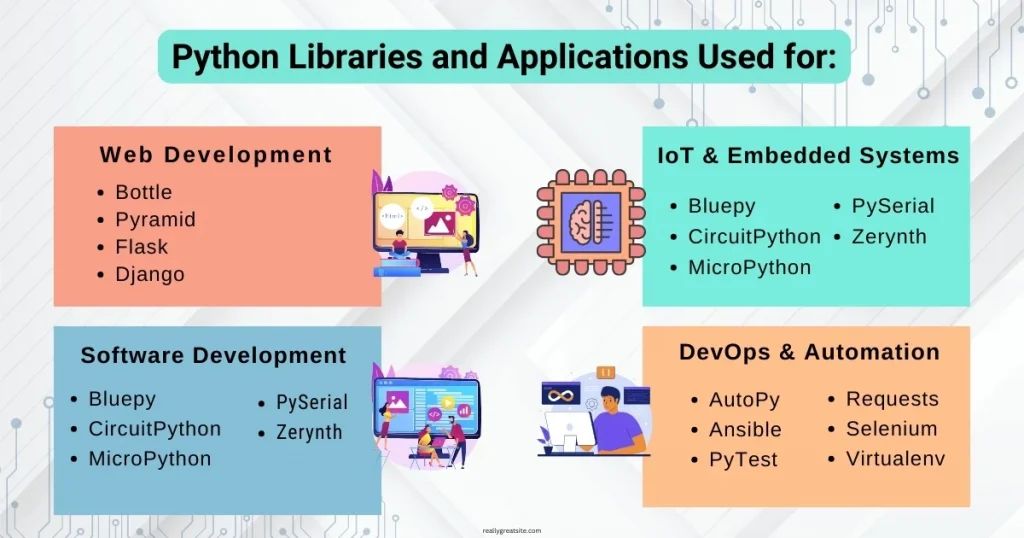
5. Artificial Intelligence & Machine Learning
Python is a popular programming language used in AI and ML. It has a versatile library that can help build AI chatbots. Moreover, the vast libraries also help with training ML models for functions such as classification, regression, and clustering. Python also helps build neural networks for computer vision, NLP, and image recognition.
Python libraries and tools for AI and ML
- Keras
It is a deep learning and neural network API integrated with TensorFlow. It is not only easy to learn but also offers a user-friendly interface for designing, training, and deploying deep learning models. - TensorFlow
This open source machine learning library is a great tool by Google for machine learning, numerical computations, and neural network development. Also, it works efficiently on CPUs and GPUs. - Scikit-learn
It is a machine learning library with tools that help with hyperparameter tuning, feature engineering, data preprocessing, model evaluation and more. - PyTorch
It is an open-source machine learning framework by Facebook AI Research Lab. PyTorch’s easy-to-use and flexible features support building deep learning models.
Real-world applications
- Amazon: Python helps Amazon operate its product recommendation efficiently by implementing sophisticated recommendation algorithms. It also helps create AI and ML models that optimize Amazon’s supply chain and improve its logistics and inventory management.
- Google: Python has not only helped Google build its search algorithms but also enhance them. In addition, it also helps with Google Search and Google Assistant’s NLP tasks.
- Spotify: Python’s advanced ML algorithms help Spotify offer music recommendations to its subscribers. Also, Python’s AI models analyze user behavior and preferences, which helps the platform personalize content for the users.
6. Image Processing & Graphic Design
Developers can integrate Python with their existing image processing and graphic design software. This makes it possible to create add-ons and plug-ins to enhance the functionality of software. Developers can use Python to apply manipulations and enhancements, perform image segmentation and object detection, apply filters and transformations, and create custom visual effects and animations.
Python libraries and tools for image processing and graphic design
- OpenCV
It is a Python library that helps with computer vision tasks and image processing. - Python Image Library This free library offers support to open, edit, and save images in different image file formats.
- Scikit-image
It is a Python package built on NumPyto and helps with image processing. It has many image processing algorithms with varied functionalities. - Pyglet
It is a cross-platform multimedia library used to develop visually rich applications. It offers features like supporting UI event handling and windowing.
Real-world applications
- Blender: It is a free and open-source 3D graphics software with Python API for plug-in and add-on development. It is used for 3D animation, motion graphics, visual effects, etc.
- GIMP: It is an open source raster graphics editor like Adobe Photoshop. With the Python-fu plugin, it can be used to create add-ons and plug-ins.
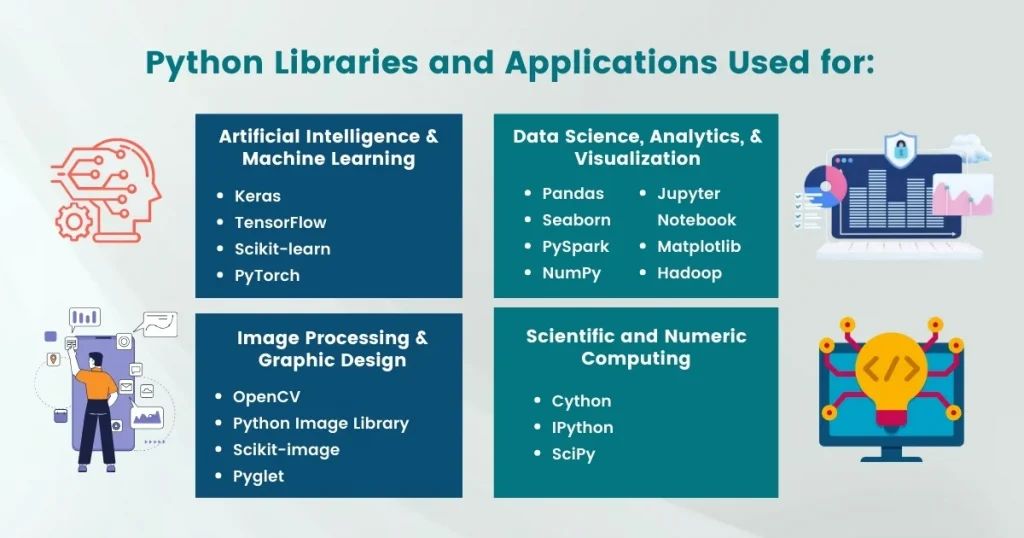
7. Data Science, Analytics, & Visualization
Python’s ecosystem of libraries makes it a top choice for data science concepts such as conducting statistical analyses, developing insightful visualizations, and performing data manipulation. Python libraries and framework help businesses make informed decisions through data-driven insights.
Python libraries and tools for Data Science, Analytics, and Visualization
- Pandas
The huge library offered by Pandas helps build extensive data science projects, as it allows you to analyze data extensively. With Pandas, developers can develop efficient and optimized objects for data manipulation in various academic and industrial fields. - Seaborn
It is a data visualization library built on Matplotlib that offers elegant aesthetics to develop informative statistical graphs and charts that are visually appealing. Its high-level interface helps come up with interactive data visualizations. - PySpark
It is a Python API for Apache Spark, an open source computing system for big data processing and analytics. PySpark offers large-scale data processing and advanced analytics with interactive data exploration. - NumPy
It offers all the required math packages for data science. It helps integrate the simplicity of C and Fortran into Python. - Jupyter Notebook
It is an open source, interactive web application that supports live code, equations, visualizations, and narrative text. It helps with prototyping, workflow sharing, and exploratory analysis. - Matplotlib
It is a data visualization library widely used in scientific computing, data analysis, and machine learning. It helps communicate crucial insights by allowing versatile visualizations to create high-quality plots and figures. - Hadoop
It facilitates distributed storage and processing of large data sets across clusters of computers. It can handle massive amounts of data parallelly through its distributed computing framework and fault-tolerant architecture.
Real-world applications
- Airbnb: Python is a part of Airbnb’s tech stack for not only data analysis but also backend services and machine learning applications. With Python-based frameworks, Airbnb can efficiently monitor demand forecasting and pricing optimization.
- Netflix: Once a DVD-by-mail service, today, Netflix is a well-known video streaming platform. Its millions of paid subscribers receive suggestions and updates through Python’s powerful analytics and recommendation algorithms.
- Uber: The mobility-as-a-service company uses Python for the backend and frontend functions, such as predicting traffic, getting insights on demand and supply, and calculating arrival times.
Read More-Is Data Science an Overhyped Trend?
8. Scientific and Numeric Computing
With Python, activities like mathematical computations, optimization, signal processing, domain-specific analysis, and parallel computing become easier for companies carrying out scientific and numeric computing. Python is widely used by researchers and scientists to analyze data snd solve complex problems in their fields.
Python libraries and tools for scientific and numeric computing
- Cython
It is a Python superset that compiles to C and speeds up computation by several orders of magnitude.
- IPython
It is an interactive interface for Python. It offers useful syntax additions for high-performance numerical computing.
- SciPy
It is a machine learning library that helps with scientific and technical computation by leveraging NumPy arrays.
Real-world application
Academic Research: Bioinformatics, biology, and mathematics are a few fields that benefit greatly from Python’s use in scientific and numerical computations and academic courses.
9. Blockchain and Smart Contracts
Decentralized and distributed ledger technologies like Blockchain benefit a great deal from the simplicity and versatility of Python libraries. The programming language offers extensive community support and documentation for effective implementation of blockchain solutions. It also makes it easy for users both new and experienced, to deploy smart contracts efficiently by automating and enforcing contract execution.
Python libraries and tools for Blockchain and Smart Contracts
- Brownie
It is a development and testing framework for Ethereum smart contracts. It offers built-in testing and debugging tools and streamlines writing, deploying, and testing smart contracts.
- SmartPy
It is a high-level smart contract language and platform designed for Tezos. With its online IDE and framework, it is easy to develop, test, and deploy Tezos blockchain smart contracts.
- Web3.py
It is a Python library that connects decentralized apps to the Ethereum blockchain. With Web3.py, it is possible for the apps to read block data, send transactions, and interact with smart contracts.
Real-world applications
- Quorum: Developed by JPMorgan Chase, Quorum is an enterprise-focused version of Ethereum. It is a Python-based blockchain platform that takes care of the specific needs of enterprises and businesses.
- Steemit: It is a blockchain-based social media and blogging platform built with STEEM-Python library. It gives contributors STEEM cryptocurrency for curating and publishing content.
10. Web Scraping
Python is widely used in web scrapping to extract data from websites. Its simplicity and readability simplify writing web scraping scripts. Python has an extensive ecosystem of libraries and frameworks that improve the capabilities of web scraping applications, allowing developers to collect and analyze data from the internet efficiently.
Python libraries and tools for web scrapping
Beautiful Soup
It is a Python library that helps with HTML/XML document parsing and web scraping.Scrapy
It is an open-source Python framework that is used for web scraping and crawling websites.Selenium
It is a Python library that has tools for browser automation and web scraping.
11. Education and Training
Python is simple and easy to learn, which makes it one of the best programming languages for beginners. Many colleges and universities offer various levels of Python courses online and offline. The programming language is taught even outside computer science, including social sciences, engineering, and natural sciences.
Python libraries and tools for education and training
Python has a vast collection of libraries dedicated to different applications and uses. Based on your area of interest, you can choose a library and explore it. For instance, if you are studying Data Science and Machine Learning, you can refer to libraries like NumPy, TensorFlow and Theano.
Real-world applications
- edX: You can sign up for Python courses from universities such as MIT and Harvard.
- Codecademy: Codecademy offers interactive Python courses suitable for beginners, focusing on hands-on coding practice. It offers free coding classes in 12 different programming languages including Python.
- Kaggle: It is a data science competition platform that provides Python courses within its platform, focusing on practical applications in data science and machine learning.

12. Game Development
Python’s simplicity and extensive libraries make it a good choice for 2D games and prototypes. It helps game developers create tools that can simplify the process of game development. Python is recommended for beginners working in the game development domain as the language is easy to learn and apply. Although there may be limitations to how much you can use Python for game development, optimized use of the Python libraries can help create a variety of games.
Python libraries and tools for game development
- Godot Python
It allows developers to use Python for scripting within the Godot Engine for game development. - Ren’Py
It is a free and open source engine that uses Python for visual novels with interactive storytelling experiences. It also provides a simple and flexible platform for life simulation games. - PyGame
It is an open source cross platform library that simplifies the creation of video games by offering features to handle graphics, sound, and input devices.
Real-world applications
- Battlefield 2: The strategy game uses Python for its server controls and game logic.
- Mount and Blade: The game has Python script for its module system.
- EVE Online: The space multi-player game is written using Stackless Python.
13. Business and Enterprise
It is a vast domain, but Python helps with the creation of efficient applications and codebases for domain-specific purposes. For example, many businesses use Python’s computer vision and image processing features to enhance their inventory management. With the help of Python, businesses and enterprises can deploy image-based quality control and automation, and facial recognition apps for security and authentication systems. Python also has tools like OCR features that can help financial companies digitize and extract document data.
Python libraries and tools for business and enterprise
- Celery
It is a Python library that can be used for handling asynchronous tasks and background processes in conjunction with Django and Flask. Celery is also used for task queue implementation.
- Dash
It is a framework that helps build interactive web applications and data visualization interfaces. It simplifies data presentation in enterprise applications.
- PySpark
It is a Python library that offers a compatible interface for Apache Spark. It is used for large-scale data processing.
Real-world applications
- Odoo: It is an open-source ERP software built with Python. It integrates various business applications, including sales, inventory, accounting, and human resources.
- Zoho CRM: It is a customer relationship management platform that helps businesses manage their sales, marketing, and customer support activities.
- Zapier: It is an automation tool that uses Python for its backend development. Zapier connects different applications to automate workflows.
14. Desktop Apps
The tools and libraries that Python has help build desktop apps. Developers can build GUIs, design data-driven desktop apps, build text editors and productivity tools, build cross-platform apps, and even develop multimedia apps using Python.
Python libraries and tools for desktop apps
- Kivy
It is an open source Python framework library that helps build multi-platform GUI applications.
- PyQT
It allows the use of many Qt libraries along with the use of Python to create desktop, web, and mobile apps.
- Tkinter
This Python library can work like a standard interface for the Tk graphics user interface (GUI) toolkit.
- wxPython
It is a cross-platform GUI toolkit that helps build apps with robust, functional GUIs easily. In addition, it is also an alternative to Tkinter.
Real-world applications
- The Dropbox Desktop client: The cloud storage service’s desktop client application uses Python to easily integrate desktop app components.
- PyCharm: It is an integrated development environment (IDE) for Python that has tools for code analysis, debugging, and support for various frameworks.
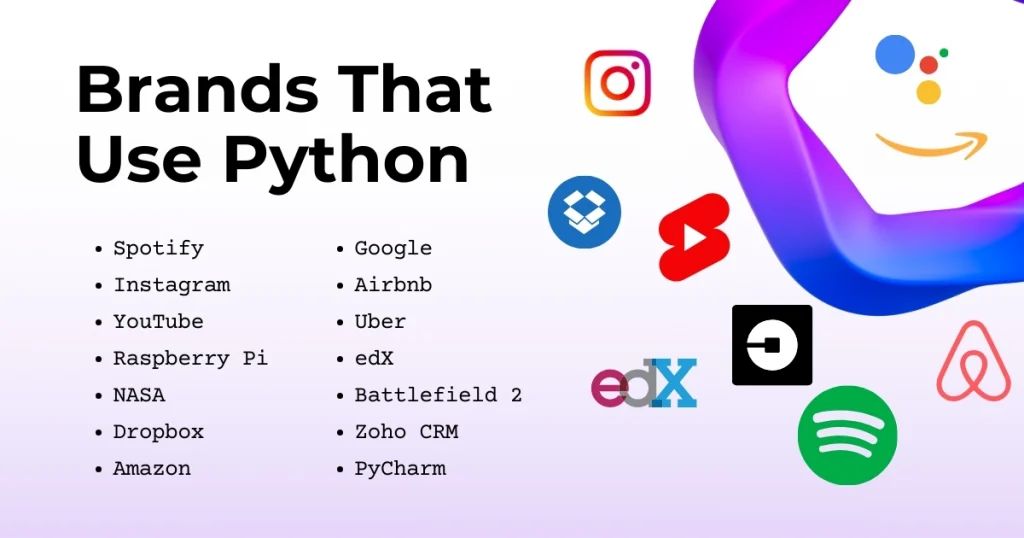
Conclusion
The top Python applications for 2024 span web development, IoT, AI, data science, and more. Through the years, Python has stood firm as a reliable and dynamic tool, demonstrating its significance across diverse industries. Moreover, Python’s robust ecosystem of libraries and frameworks continues to drive innovation and efficiency across various domains. For example, from web development and data science to artificial intelligence and automation, Python is shaping the technological landscape steadily. In addition, the rise of Industry 4.0 technologies amplifies Python’s significance in areas like IoT, software development, and AI. With its extensive libraries, easy-to-use tools, and vast community support, Python has been admired as a powerhouse for various real-world applications. Whether you own a business, use a service, or are a learner, Python is a driving force facilitating innumerable businesses and organizations with its adaptability and simplicity. Python’s dominance in the programming world is poised to continue in 2024, and its evident by its widespread usage across diverse applications and industries.
FAQs
Python is widely used across domains including web development, data science, automation, software testing, and artificial intelligence.
Python has versatile and extensive libraries that simplify many tasks, ranging from building websites and applications to conducting complex data analysis and machine learning.
Leading companies such as Netflix, Spotify, Dropbox, and Google use Python to operate seamlessly.
Python will demonstrate continued stability and growth in the coming years. 2024 shows a healthy and sustained demand across various domains like data science and machine learning.

